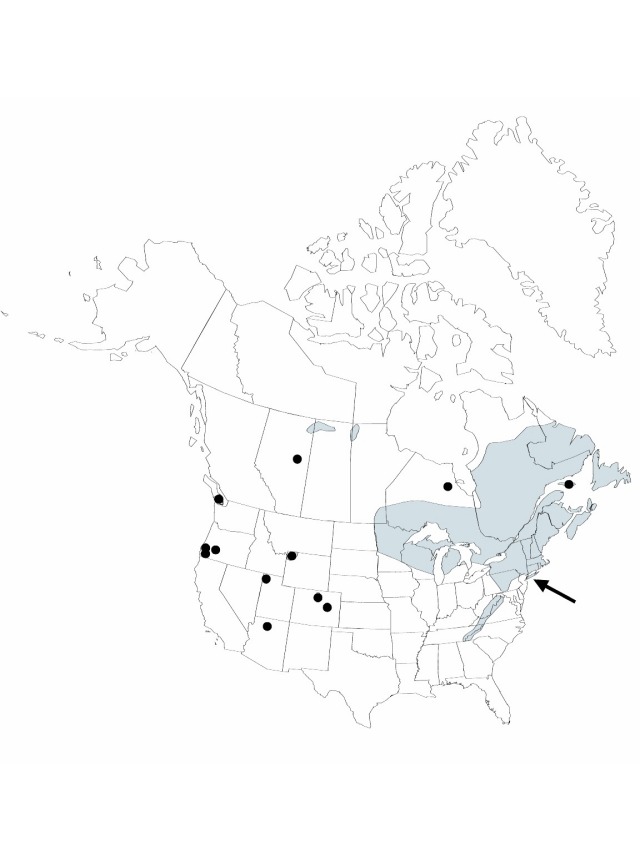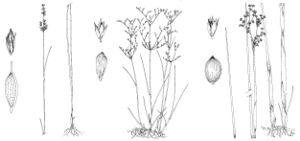Difference between revisions of "Juncus tweedyi"
Mem. New York Bot. Gard. 1: 90. 1900.
GeoffLevin (talk | contribs) m (GeoffLevin moved page Juncus brevicaudatus to Juncus tweedyi: The name Juncus tweedyi has priority over the name Juncus brevicaudatus) |
GeoffLevin (talk | contribs) (Edited Juncus brevicaudatus page to become Juncus tweedyi page) |
||
| Line 1: | Line 1: | ||
{{Treatment/ID | {{Treatment/ID | ||
| − | |accepted_name=Juncus | + | |accepted_name=Juncus tweedyi |
| − | |accepted_authority= | + | |accepted_authority=Rydberg |
|publications={{Treatment/Publication | |publications={{Treatment/Publication | ||
| − | |title= | + | |title=Mem. New York Bot. Gard. |
| − | |place= | + | |place=1: 90. 1900 |
| − | |year= | + | |year=1900 |
}} | }} | ||
|common_names=Narrow-panicled rush | |common_names=Narrow-panicled rush | ||
| Line 15: | Line 15: | ||
|label=Endemic | |label=Endemic | ||
}} | }} | ||
| − | |basionyms={{Treatment/ID/ | + | |basionyms= |
| + | |synonyms={{Treatment/ID/Synonym | ||
| + | |name=Juncus brevicaudatus | ||
| + | |authority=(Engelmann) Fernald | ||
| + | |rank=species | ||
| + | }} {{Treatment/ID/Synonym | ||
|name=Juncus canadensis var. brevicaudatus | |name=Juncus canadensis var. brevicaudatus | ||
|authority=Engelmann | |authority=Engelmann | ||
|rank=variety | |rank=variety | ||
| − | + | }} {{Treatment/ID/Synonym | |
| − | |||
| − | }} | ||
| − | |||
|name=Juncus canadensis var. coarctatus | |name=Juncus canadensis var. coarctatus | ||
|authority=Engelmann | |authority=Engelmann | ||
| Line 36: | Line 38: | ||
}} {{Treatment/ID/Synonym | }} {{Treatment/ID/Synonym | ||
|name=Juncus kuntzei | |name=Juncus kuntzei | ||
| − | |authority= | + | |authority=(Buchenau) Vierhapper |
| − | |||
| − | |||
| − | |||
| − | |||
|rank=species | |rank=species | ||
| − | }} | + | }} |
| − | |hierarchy=Juncaceae;Juncus;Juncus subg. Septati;Juncus | + | |hierarchy=Juncaceae;Juncus;Juncus subg. Septati;Juncus tweedyi |
| − | |hierarchy_nav=<div class="higher-taxa"><div class="higher-taxon"><small>family</small>[[Juncaceae]]</div><div class="higher-taxon"><small>genus</small>[[Juncus]]</div><div class="higher-taxon"><small>subgenus</small>[[Juncus subg. Septati]]</div><div class="higher-taxon"><small>species</small>[[Juncus | + | |hierarchy_nav=<div class="higher-taxa"><div class="higher-taxon"><small>family</small>[[Juncaceae]]</div><div class="higher-taxon"><small>genus</small>[[Juncus]]</div><div class="higher-taxon"><small>subgenus</small>[[Juncus subg. Septati]]</div><div class="higher-taxon"><small>species</small>[[Juncus tweedyi]]</div></div> |
|volume=Volume 22 | |volume=Volume 22 | ||
|mention_page= | |mention_page= | ||
| Line 65: | Line 63: | ||
-->{{#Taxon: | -->{{#Taxon: | ||
| − | name=Juncus | + | name=Juncus tweedyi |
| − | |authority= | + | |authority=Rydberg |
|rank=species | |rank=species | ||
|parent rank=subgenus | |parent rank=subgenus | ||
| − | |synonyms=Juncus canadensis var. coarctatus;Juncus canadensis var. kuntzei;Juncus coarctatus;Juncus kuntzei | + | |synonyms=Juncus brevicaudatus;Juncus canadensis var. brevicaudatus;Juncus canadensis var. coarctatus;Juncus canadensis var. kuntzei;Juncus coarctatus;Juncus kuntzei |
| − | |basionyms= | + | |basionyms= |
|family=Juncaceae | |family=Juncaceae | ||
|phenology=Fruiting mid summer–fall. | |phenology=Fruiting mid summer–fall. | ||
| Line 77: | Line 75: | ||
|distribution=Alta.;B.C.;Man.;N.B.;Nfld. and Labr.;N.S.;Ont.;P.E.I.;Que.;Sask.;Ariz.;Colo.;Conn.;Maine;Md.;Mass.;Mich.;Minn.;Mont.;N.H.;N.Y.;N.C.;Oreg.;Pa.;R.I.;Tenn.;Utah;Vt.;Va.;W.Va.;Wis.;Wyo. | |distribution=Alta.;B.C.;Man.;N.B.;Nfld. and Labr.;N.S.;Ont.;P.E.I.;Que.;Sask.;Ariz.;Colo.;Conn.;Maine;Md.;Mass.;Mich.;Minn.;Mont.;N.H.;N.Y.;N.C.;Oreg.;Pa.;R.I.;Tenn.;Utah;Vt.;Va.;W.Va.;Wis.;Wyo. | ||
|reference=None | |reference=None | ||
| − | |publication title= | + | |publication title=Mem. New York Bot. Gard. |
| − | |publication year= | + | |publication year=1900 |
|special status=Illustrated;Endemic | |special status=Illustrated;Endemic | ||
|source xml=https://bitbucket.org/aafc-mbb/fna-data-curation/src/2e0870ddd59836b60bcf96646a41e87ea5a5943a/coarse_grained_fna_xml/V22/V22_274.xml | |source xml=https://bitbucket.org/aafc-mbb/fna-data-curation/src/2e0870ddd59836b60bcf96646a41e87ea5a5943a/coarse_grained_fna_xml/V22/V22_274.xml | ||
|genus=Juncus | |genus=Juncus | ||
|subgenus=Juncus subg. Septati | |subgenus=Juncus subg. Septati | ||
| − | |species=Juncus | + | |species=Juncus tweedyi |
}}<!-- | }}<!-- | ||
-->[[Category:Treatment]][[Category:Juncus subg. Septati]] | -->[[Category:Treatment]][[Category:Juncus subg. Septati]] | ||
Revision as of 14:12, 4 October 2022
Herbs, perennial, cespitose, 1.4–5.5(–7) dm. Culms erect, terete, 1–3 mm diam., smooth. Cataphylls 0–1, straw-colored to pink, apex acute. Leaves: basal 1–3, cauline 1–2; auricles 0.5–3 mm, apex rounded to truncate, scarious; blade terete, 1.5–25 cm × 0.5–2.5 mm. Inflorescences terminal panicles or racemes of 2–35 heads, 1–12 cm, branches erect; primary bract erect; heads 2–8-flowered, ellipsoid to narrowly obconic, 2–9 mm diam. Flowers: tepals green to light brown, lanceolate; outer tepals 2.3–3.1 mm, apex acuminate to rarely obtuse; inner tepals 2.5–3.2 mm, apex acuminate; stamens 3 (or 6), anthers 1/4–1/2 filament length. Capsules exserted, chestnut brown, imperfectly 3-locular, narrowly ellipsoid to prismatic, 3.2–4.8 mm, apex acute proximal to beak, valves separating at dehiscence. Seeds fusiform, 0.7–1.2 mm, tailed; body covered with whitish translucent veil. 2n = 80.
Phenology: Fruiting mid summer–fall.
Habitat: Generally in acidic or peaty moist sites, including emergent shorelines and aroundg hot springs
Elevation: 100–2500 m
Distribution

Alta., B.C., Man., N.B., Nfld. and Labr., N.S., Ont., P.E.I., Que., Sask., Ariz., Colo., Conn., Maine, Md., Mass., Mich., Minn., Mont., N.H., N.Y., N.C., Oreg., Pa., R.I., Tenn., Utah, Vt., Va., W.Va., Wis., Wyo.
Discussion
Populations from around hot springs in the western United States have been treated as Juncus tweedyi, with the remaining populations called J. brevicaudatus, but no morphologic distinction appears to exist between the two taxa. This species was called J. brevicaudatus in the print edition of the Flora of North America; however, that name at the rank of species was published in 1904 so the name J. tweedyi has priority.
Selected References
None.
